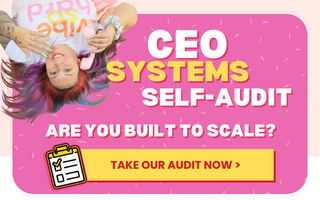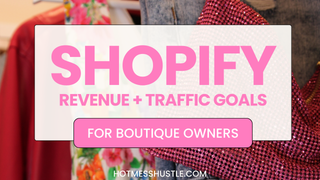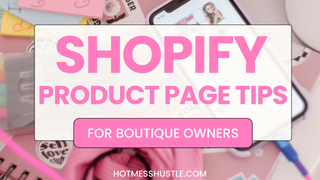Well hi there boutique owner and welcome back!👋
This is our third installment in our copywriting series! In this Q&A, our very own Hot Mess Head Copywriter Jessica Rae chatted with copywriter Alex Turner and Hot Mess Head of Marketing Rebekah Pearson about a specific element of copywriting that is important to each and every brand out there… storytelling!
VIDEO MORE YOUR JAM? WATCH IT HERE:
We love stories as much as the next boutique owner, so we are very excited to dig into this with you. So today we are looking at...
❓ Why is storytelling important for an ecommerce business?
❓ How do you tell your brand story?
❓ Where can you tell your brand story?
❓ What are some of the biggest challenges with writing about pages?
Storytelling is a huge part of your brand, so get cozy and grab a pen - we think you’re gonna want to make some notes here!
First up, let’s look at why we are so obsessed with stories...
Need help optimizing your website to increase your revenue?
That's what we do!
Why is storytelling important for an ecommerce business?
If we go back through to ages, before the internet and ecommerce was even invented (yes if you can believe it, there was such a time 😅), there is one thing that is common to all generations. Telling stories. Humans love stories! We are hardwired for it. Stories are a way to teach, inform, and entertain. They help us connect, and these days, that includes with online brands.
Stories give another dimension or depth to your content and to your business for your customers to relate and connect to. They also help you stand out from your competitors.
This helps you build your brand with the right customers and the story (or stories) can help you create a consistent and memorable narrative that your customers can connect with.
How do you tell your brand story?
Your story is all about your why. Sharing your why with your customers allows them to see why you got into business in the first place, and what you’re here to do. If they share the same values, they will be onboard, ignoring the brands that do not share their values. Some parts of your story may help develop trust, or empathy, or even just understanding. It might even entertain them at points!
In order to get clear on what your why is, ask yourself ‘Why does your brand exist?’ One really successful technique to get to the deeper answer is to ask ‘why’ 5 times - so each time you get an answer, ask yourself why again, and let yourself uncover the little kernel of truth, the real why, sitting behind the more obvious answers.
Think about it: one of the more straightforward answers might be that you started your boutique to make money. But if you ask why, maybe it’s because you didn’t want to work for someone else, you wanted to have control over your time, energy and what you do for an income. And if you ask why, maybe it’s because you value freedom.
So then you’re starting to get closer to your truth, and that will likely resonate strongly with your ideal buyer too.
Your story underpins your brand - so it really is worth digging into what that story is and how it shows up in your business. This includes the sequence of events of why and how you started and grew your business - and not just the good bits! People connect most with stories about overcoming challenges and adversity. Storytelling often follows an arc: a main character, perhaps a backstory, an event or a conflict, followed by a resolution or a lesson.
The aim is to tell a story that engages people and moves them to really connect with you. But it must be truthful, and it must reflect the personality of your brand. This builds trust and loyalty, as well as a highly engaged audience.
So once you’re clear on your brand story, what then?! Where do you put it?
Where can you tell your brand story?
One of the most common places to tell your brand story is in your About Page. But before you go dumping in your whole biography, remember that you really just have a few seconds to grip a visitor’s attention.
This is where a lot of people go wrong with their about page - they’re either too generic, or they’re too long, full of frankly boring information that doesn’t mean a huge amount to their audience.
But done well, you can weave some compelling stories through your About Page which let your audience know about you, and even see some of their own experiences or values in your brand story.
To maintain a consistent narrative, don’t stop there! Weave in elements throughout your blogs, social media posts and product pages - dropping little breadcrumbs all the way through your content to hook in your readers and allow them to connect with you.
Weave your values and your experiences into the product descriptions so that you draw your buyer in - when they buy from you, they are buying into the story and becoming part of it. Make them feel that way! Customers today are not just buying products, they are buying stories - and they know it.
And of course, testimonials are also part of your story because they tell the customers' experience of your brand - these are powerful stories to share!
What are some of the biggest challenges that clients have when writing their about page?
We know that everyone has an interesting story! But we often fail to see that in ourselves.
It’s normal to find it hard to talk or write about yourself, and it can be super hard to toot your own horn. That’s why having an outside person like a copywriter come in and see all the interesting, intricate details and be able to pull it all out into a compelling story can be so liberating (and a time- and money-saver!).
Similarly, it can be tricky to find the flow of the story, or tell it in a way that makes sense to a buyer or customer. People often get bogged down in the details because they feel that the details are important - but the details can be less relevant to someone who doesn’t know you. So the trick is to keep it simple and stick to a core message, the core value in the story, and try not to deviate too far from the path.
As we mentioned earlier, business owners can give too much detail, but another challenge is that the information they give is too generic. But people don’t connect with generic information.
Listing off stats or a chronological timeline about your company might sound impressive, but it is likely to send them off to sleep...
And we don't want that!
Like we said in Part 2, people make 90% of their decisions based on emotion - and one of the best ways to emotionally connect with someone is through stories - not relaying facts. If you find yourself getting bogged down in facts, go back to your why, and start from there. No one really cares where your headquarters are, but they might be more interested in some of the challenges you’ve overcome while starting up, or even just a peek behind the scenes ;)
We know this can all be quite daunting and quite a lot to take in, but don’t panic! A template can be an easier place to start, and that’s something we love to share with our clients to take some of the pressure off.
One other tip is to write in the first person - let the reader connect with you and your voice. Telling a story or a narrative in the first-person invites the reader right into the front row. This helps build trust and rapport, whereas writing in the third person (she/her, or they/them/their) puts distance between you and the reader and makes it harder to connect.
Final Thoughts
People think in stories, not statistics, and marketers need to be master storytellers.’ – Arianna Huffington
Storytelling is part of the human condition, and because people love stories, it’s a really engaging way to write content, connect with your customers, build trust and build your brand.
So... Are you ready to tell your story?
Cheers to your brand story!
💋💋💋
PS if you have a good story, share it in the comments, we’d love to hear it!!






